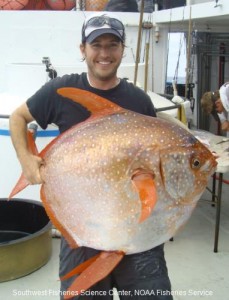If you think back to biology class, you most likely learned that endothermy, or the ability to maintain a body favorable body temperature (i.e., different than the ambient temperature), was a unique characteristic of mammals and birds. This ability sets “warm blooded” animals apart from “cold blooded” ectotherms such as reptiles and fish.

For fish, one of the biggest challenges to maintaining an elevated body temperature is convective heat loss in the gill lamellae. There are a few fish species that are able to retain some of the heat generated internally, but these “regional endotherms” are only able to increase the temperature of specific areas or tissues. Regional endotherms limit the heat loss with retia mirabilia, which are a complex network of blood vessels that act as counter-current heat exchangers that warm the cold arterial blood as it returns from the gills. However, these retia have only been found associated with specific muscle groups and organs, and as a result the rest of the fish’s body remains at ambient temperature.
A silver and crimson-colored, tire-sized, fish called the opah (Lampris guttatus), or moonfish, is changing what scientist thought they knew about endothermy in fish (1). The opah lives in the cold, dim waters of the ocean’s mesopelagic zone hundreds of feet below the surface. Unlike other fish at these depths, the opah is a fast swimming, agile predator. Its secret is retia located inside the gills. The location of the retia means that the opah can maintain an elevated body temperature throughout its body, and a warmer body temperature means it can swim faster and react more quickly than both its prey and other predators.
I don’t think that we should throw out all our biology text books and start rewriting descriptions of what defines a fish, but the discovery of the warm blooded opah should remind us that what we know is just a small drop compared to what remains to be discovered.
Reference
- Wenger, N. et al. (2015) Whole-body endothermy in a mesopelagic fish, the opah, Lampris guttatus. Science 348, 786–9.
